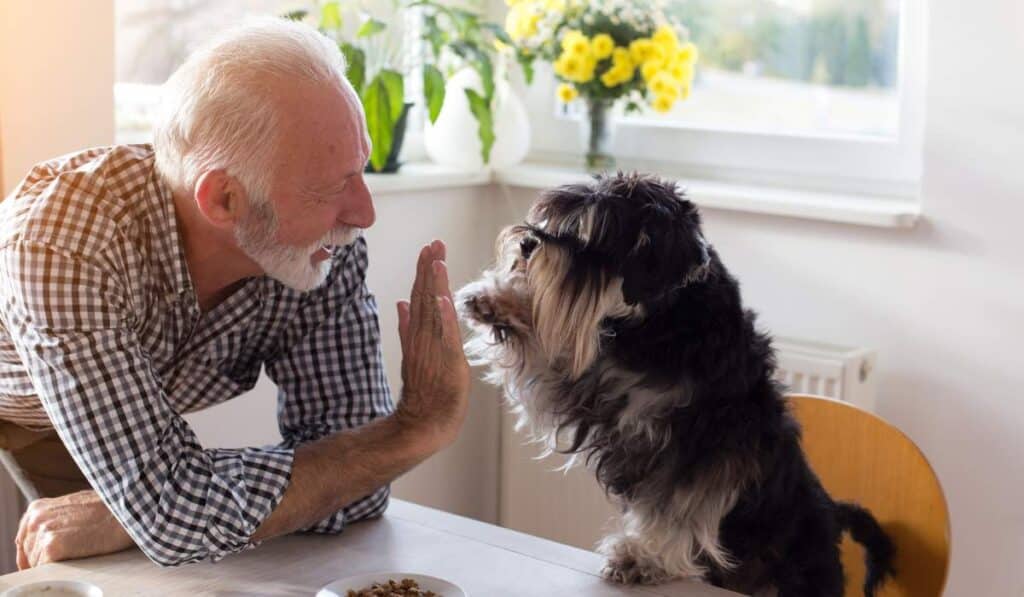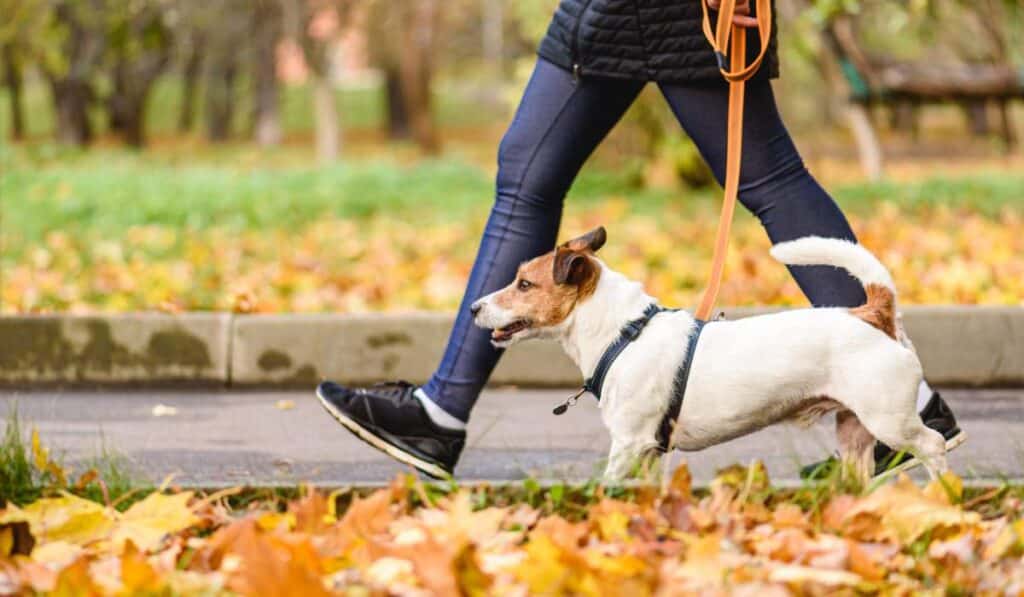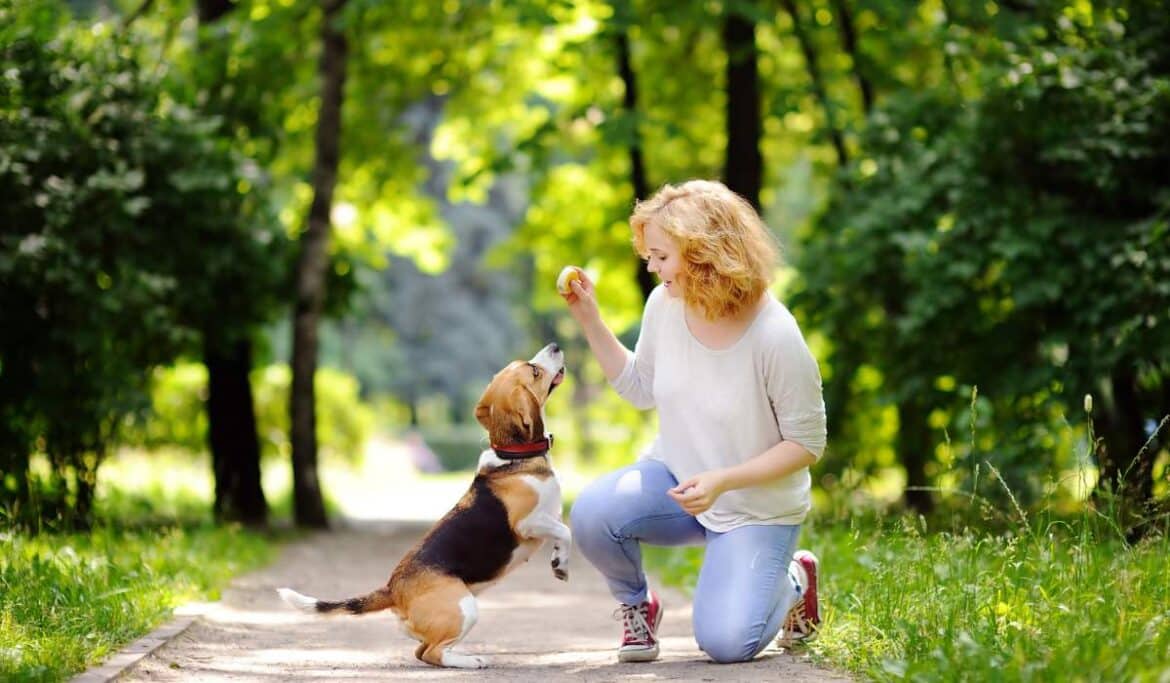Are you a new dog owner wondering how to teach your furry friend some basic commands? Or maybe you have an older dog who needs a refresher on their training? Whatever the case may be, teaching your dog basic commands is essential for their safety and overall behavior. Basic commands like “sit,” “stay,” and “come” form the foundation of dog training.
To begin training your dog, start with one command at a time and repeat it consistently in short sessions. Showing your dog the action and using their name to associate the command can help them learn faster. For example, when teaching “sit,” gently push down on their hindquarters while saying “sit” and then reward them with praise or treats when they comply.
We’ll cover useful actions like “take it” and “drop it” that can come in handy during walks or playtime. By following these tips, you’ll have a well-trained pup who knows how to behave on and off the floor!
Understanding Your Dog’s Learning Style

As a dog owner, it’s important to understand that each dog has its own unique learning style. Just like humans, dogs have different ways of processing and retaining information. Understanding your dog’s learning style can help you teach them basic commands more effectively.
Dogs Have Different Learning Styles
Dogs learn in various ways, including visual, auditory, kinesthetic, and tactile. Visual learners rely on seeing things to understand them while auditory learners prefer hearing things explained to them. Kinesthetic learners need hands-on experience to learn while tactile learners need touch and feel.
To determine your dog’s learning style, observe how they react when you try to teach them something new. For example, if your dog responds well to verbal cues but struggles with hand signals or physical prompts, it may be an auditory learner.
Structured Classes Can Benefit Some Dogs
While some dogs may respond well to at-home training sessions with their owners, others may benefit from a structured class environment. These classes provide a controlled setting where dogs can focus on learning without distractions.
In a class setting, dogs also have the opportunity to socialize with other dogs and people outside of their immediate family. This socialization is crucial for puppies who are still developing their social skills.
Patience and Consistency are Key
Regardless of your dog’s learning style or the training method you choose, patience and consistency are key factors in teaching basic commands. It takes time for dogs to learn new behaviors and retain information.
When teaching your dog basic commands such as “sit,” “stay,” or “come,” use positive reinforcement techniques such as treats or praise when they perform the desired behavior correctly. Avoid using punishment or negative reinforcement as this can cause confusion and anxiety in your pet.
It’s also important to be consistent with your training efforts by practicing regularly in short sessions rather than long ones. Shorter sessions help keep your dog engaged and focused on the task at hand.
Importance of Consistency in Dog Training
Training your dog is an essential part of being a responsible pet owner. Not only does it help to ensure that your furry friend is well-behaved and obedient, but it also strengthens the bond between you and your dog. However, one of the most important factors in successful dog training is consistency.
Consistency is Key
Consistency is key. Dogs are creatures of habit and thrive on routine. They learn through repetition and reinforcement, so it’s essential to be consistent with both. This means using the same commands every time you ask your dog to perform a task and rewarding them every time they do so successfully.
Reinforcement Must Be Consistent
Reinforcement is an integral part of dog training, but it must be consistent for it to be effective. If you reward your dog one day for performing a task correctly but fail to do so the next day when they repeat the same behavior, they will become confused and frustrated. This inconsistency can lead to disobedience and make future training sessions more challenging.
To ensure that reinforcement remains consistent throughout the training process, establish clear rules for rewards from the outset. Decide what behaviors merit praise or treats and stick to these guidelines consistently.
Inconsistent Training Can Confuse Your Dog
Inconsistent training can confuse and frustrate your furry friend. Dogs are intelligent animals that can quickly pick up on changes in their environment or routine. If you change the way you train or reinforce commands regularly, your pet may become unsure about what behavior they should exhibit.
This confusion can result in disobedience or even anxiety in some dogs. To avoid this situation, maintain a regular schedule for training sessions and use consistent language when issuing commands.
Why Should You Train Your Dog?
Training your dog has several benefits beyond just having a well-behaved pet. It can also help to keep your dog safe by teaching them commands like “come” or “stay.” Training can strengthen the bond between you and your furry friend.
Dogs are social animals that crave attention and affection. When you train your dog, you’re spending quality time with them and showing them that you care. This bonding experience can lead to a happier, healthier relationship between you and your pet.
Essential Basic Commands for Your Dog

Teaching your dog basic commands is one of the most important things you can do as a pet owner. These commands help keep your dog safe and happy, whether they’re at home in their bed or out on a walk with their equine friends.
What are the Basic Commands to Teach a Dog?
There are several basic commands that every dog should learn. Some of these include:
Sit
Teaching your dog to sit is one of the first things you should do when training them. This command helps keep your dog calm and focused, making it easier to teach them other commands.
To teach your dog to sit:
- Hold a treat close to your dog’s nose.
- Move the treat up and back towards their ears.
- As your dog’s head moves up, its butt will naturally lower down into a sitting position.
- Once they’re sitting, give them the treat and praise them.
Stay
The “stay” command teaches your dog self-control and helps keep them safe in potentially dangerous situations.
To teach your dog to stay:
- Have your dog sit in front of you.
- Hold out an open hand in front of their face and say “Stay.”
- Take a step back while keeping eye contact with your pet.
- If they stay put, reward them with praise or treats.
Come
The “come” command is important for keeping dogs safe when off-leash or in unfamiliar environments.
To teach your dog to come:
- Attach a long leash (30-50 feet) to their collar.
- Say “come” while gently pulling on the leash towards you.
- As soon as they start moving towards you, praise them and give them treats once they reach you.
Heel
The “heel” command teaches your dog to walk calmly beside you, rather than pulling or wandering off.
To teach your dog to heel:
- Start with your dog on a leash.
- Hold the leash in one hand and a treat in the other.
- Walk forward while holding the treat close to your leg.
- If they start to pull or wander, say “heel” and gently guide them back into position.
- Reward them with praise or treats when they stay by your side.
What Basic Commands to Teach a Puppy?
If you have a puppy, it’s important to start training them as soon as possible. Here are some basic commands that are perfect for puppies:
Leave It
The “leave it” command teaches your puppy not to eat or play with things they shouldn’t.
To teach your puppy to leave it:
- Show them an object (e.g., toy, food) and say “Leave it.”
- If they try to touch or grab the object, cover it with your hand and say “no.”
- Once they stop trying to get the object, give them praise and treats.
Teaching “Speak” and “Quiet” Commands
Teaching your dog basic commands is essential for their safety and well-being.
Using a Cue for the “Speak” Command
The first step in teaching your dog to speak on command is choosing a cue word or sound. You can use any word or sound that you prefer, but it should be consistent every time you give the command. Here are some tips for using a cue:
- Choose a short and simple word or sound that is easy to remember.
- Use an enthusiastic tone of voice when giving the command.
- Repeat the cue several times until your dog starts barking.
- Reward your dog with treats and praise when they respond correctly.
Hand Signals for “Speak” and “Quiet”
Hand signals can be an effective way to teach your dog both the “Speak” and “Quiet” commands. Here’s how to do it:
- Start by teaching your dog a hand signal for the “Speak” command. Hold up one finger in front of your face while saying the cue word or sound.
- When your dog barks, reward them with treats and praise.
- Once they have learned the hand signal, try giving them the command without saying anything.
- To teach the “Quiet” command, hold up two fingers in front of your face while saying “quiet.”
- When your dog stops barking, reward them with treats and praise.
- Practice both hand signals regularly until they become second nature to your pet.
Teaching The Quiet Command
The quiet command teaches dogs not only how to bark on command but also how to stop barking when commanded to do so.
To teach this important skill:
- Start by commanding your dog to sit and wait in a calm position.
- Once they are calm, give the “Speak” command and wait for them to bark.
- After a few seconds of barking, give the “Quiet” command and hold up two fingers in front of your face.
- When your dog stops barking, reward them with treats and praise.
- Repeat this process several times until your dog learns to stop barking on command.
Consistency is Key
Consistency is essential when teaching your dog basic commands, especially during the summer months when they may be more easily distracted. Here are some tips for staying consistent:
- Use the same cue word or sound every time you give a command.
- Practice commands regularly in different environments, such as indoors and outdoors.
- Reward good behavior with treats and praise every time.
- Be patient – it may take several weeks or even months for your dog to learn all the basic commands.
Tips and Techniques for Effective Dog Training

Use Positive Reinforcement During Training Sessions
One of the most effective ways to teach your dog basic commands is through positive reinforcement. This means rewarding your dog for good behavior, rather than punishing them for bad behavior. Dogs respond well to treats, praise, and affection, so be sure to reward them with these things when they do something right.
Pro Tip: Use high-value treats like small pieces of cooked chicken or cheese to motivate your dog during training sessions.
It’s important to remember that dogs don’t understand punishment in the same way humans do. Yelling at or physically punishing your dog can actually make them more anxious and less likely to learn. Instead, focus on rewarding the behaviors you want to see more of.
Practice Tricks and Exercises Regularly for Effective Puppy Training
Consistency is key. Make sure you’re practicing tricks and exercises regularly so that your dog has plenty of opportunities to learn and reinforce good behaviors.
Training sessions should be short (around 10-15 minutes) but frequent (at least once a day). This will help keep your dog engaged and prevent them from becoming bored or frustrated.
Pro Tip: Vary the times and locations of training sessions so that your dog learns to respond in different environments.
Some basic commands you may want to work on with your puppy include:
- Loose-leash walking
- Coming when called
- Staying in place
- Sitting on command
Professional Dog Trainers Can Offer Great Supplements To Your Own Training Advice
While it’s certainly possible to train your own dog using online resources or books, working with a professional trainer can offer some great benefits. A skilled trainer can provide personalized advice based on your specific needs and goals, as well as help troubleshoot any issues you may be having with training.
Cesar Millan, one of the world’s most renowned dog trainers, recommends finding a trainer who uses positive reinforcement techniques and focuses on building a strong relationship between you and your dog.
Pro Tip: Look for trainers who use force-free methods and have experience working with dogs of all ages and breeds.
Remember that training your dog takes time and patience. With consistent practice, positive reinforcement, and perhaps the help of a professional trainer, you can teach your furry friend basic commands that will make both of your lives easier and more enjoyable.
Checking for Pet Food Recalls: Keeping Your Dog Safe
As a responsible pet owner, keeping your dog safe and healthy is your top priority. One of the biggest threats to your furry friend’s well-being is contaminated food. With recalls happening more frequently than we’d like, it’s crucial to stay informed about potential risks and how to prevent them.
Why Checking for Pet Food Recalls Is Important
Pet food recalls happen when there are concerns that the product may be harmful to pets or humans. These concerns can arise from contamination with bacteria such as Salmonella or Listeria, foreign objects in the food, or even incorrect labeling. Consuming contaminated food can lead to serious health issues for your dog, including vomiting, diarrhea, dehydration, and in severe cases, death.
Common Foods That Are Toxic to Dogs
It’s not just recalled pet food that you need to worry about; some common household foods can also be toxic to dogs. Grapes and raisins can cause kidney failure in dogs, while onions and garlic can damage their red blood cells and lead to anemia. Chocolate contains a substance called theobromine that dogs cannot metabolize properly, which can cause vomiting, diarrhea, seizures, and even death.
As a responsible pet owner, it’s essential to keep these foods away from your dog at all times.
How To Check For Pet Food Recalls
To ensure that your dog’s food is safe and free from any recall:
- Keep track of the brand and type of food you’re feeding your dog.
- Sign up for email alerts from the FDA or other regulatory agencies regarding pet food recalls.
- Check online resources such as the FDA website or social media accounts of pet food brands.
- Contact the manufacturer directly if you have any concerns about their products.
Remember that toys and traditional diets are not immune to recalls either! Stay informed about any potential risks by checking for recalls regularly.
Prevention Is Key
Preventing your dog from consuming contaminated food is the best way to keep them safe and healthy. Here are some tips to help you do just that:
- Always wash your hands before and after handling pet food.
- Store pet food in a cool, dry place away from direct sunlight.
- Check the expiration date on the bag of pet food before purchasing it.
- Keep an eye out for any unusual signs or symptoms in your dog, such as vomiting, diarrhea, or lethargy.
If you suspect that your dog has consumed contaminated food, contact your veterinarian immediately.
Mastering Basic Commands for a Well-Trained Dog

Teaching your dog basic commands is essential, whether you have a new puppy or a service dog. Obedience training can help young puppies learn impulse control and good behavior, while also providing mental stimulation and building trust between you and your pup.
Why Basic Commands Are Important
Basic obedience commands provide structure and boundaries for your dog. They help establish you as the pack leader and give your dog clear expectations for their behavior. Many dogs require basic obedience skills for day-to-day activities such as walking on a leash or interacting with other dogs in public spaces.
How to Teach Basic Commands
When teaching basic commands to your puppy or older dog, it’s important to use positive reinforcement techniques such as treats, toys, or praise. This helps create a positive association with the command and encourages repeat behavior.
Here are some tips for teaching common basic commands:
- Sit: Start by holding a treat close to your dog’s nose and slowly move it up towards its head. As they follow the treat with their nose, their bottom should naturally lower into a sitting position. Once they’re seated, say “sit” and give them the treat.
- Stay: Begin by having your dog sit in front of you. Place your hand in front of their face like a stop sign and say “Stay.” Take one step back from your pup while still facing them. If they stay in place for several seconds, reward them with praise or treats.
- Come: Start by calling out “come” in an excited tone while backing away from your pup. Use treats or toys as motivation if necessary.
- Down: Have your pup sit in front of you then hold a treat near the ground between their front paws. As they follow the treatment, their body should naturally lower into a down position. Once they’re laying down, say “down” and give them the treat.
What to Teach After Basic Commands
Once your dog has mastered basic obedience commands, you can move on to more advanced skills such as loose leash walking or hand signals. Loose leash walking is an important skill for many dogs to master and can be achieved through consistent training and positive reinforcement.
Hand signals are another way to work on obedience with your pup. They can be a quick and fun way to communicate with your dog without having to use verbal cues. For example, holding out a flat hand with fingers together can signal “stay,” while pointing in a certain direction can indicate which way you want your dog to go.
The Order of Teaching Commands
There’s no one-size-fits-all approach. However, it’s generally recommended that you start with sit, stay, come, and then move on to down.
When teaching more advanced skills like loose leash walking or hand signals, it’s important to build upon the foundation of basic obedience commands.
Conclusion
Teaching your dog basic commands is an essential part of owning a pet. Understanding your dog’s learning style and the importance of consistency are key factors in successful training. Essential basic commands such as sit, stay, and come are important for your dog’s safety and well-being. Teaching “speak” and “quiet” commands can also be beneficial for managing barking behavior. Tips and techniques such as positive reinforcement can make training more effective.
It’s also important to keep your dog safe by checking for pet food recalls regularly. By mastering basic commands, you can have a well-trained dog that is a joy to be around.
Remember, training takes time and patience, but with the right approach, it can be a rewarding experience for both you and your furry friend.
Frequently Ask Questions (FAQs)
How long does it take to train a dog?
Training times vary depending on the individual dog’s personality, breed, age, and previous experiences. It may take several weeks or even months to fully train a dog.
Can I train my older dog?
Yes! Dogs of any age can learn new tricks with the right approach and patience
Should I use punishment when training my dog?
No! Punishment is not an effective way to train dogs. Positive reinforcement is a much better approach.
What if my dog doesn’t seem interested in training?
Try using different treats or toys as rewards or finding ways to make training more fun for your pup.
Can I hire a professional trainer?
Yes! A professional trainer can help teach you how to effectively train your dog or do the training for you if needed.

